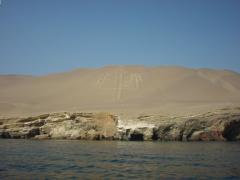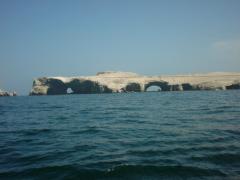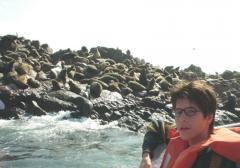Pacific Coast
The lowlands of Peru lying along the Pacific coast represent
one of the three major climate zones in that country -- the
others being the Altiplano highlands and the Amazonian jungle.
The coastal region is a barren, desolate, forlorn, desert
wasteland, punctuated by smallish oases, of which Lima is
one, created by rivers wandering down from the mountains out
to sea.
And this area also appears to be very poor, depressingly
so. Even the approach into Lima airport comes in over horribly
poverty-stricken shantytowns. Driving south from Lima, small
ramshackle groupings of buildings dot the roadside. Many of
the buildings and the omnipresent brick walls, many of which
do not appear to divide anything meaningful from anything
else, are covered with political slogans from the campaign
which occurred in the first half of 2000, ending in Fujimori's
victory in the disputed and boycotted run-off election. If
half the paint and human energy used to paint these banners
on crumbling walls in the desert had been devoted to productive
purposes, Peru would certainly be a better place.
|
|
Lima. Most visitors to
Peru will start in Lima, on the Pacific Coast. Bob and
Ko were no exception, arriving in Lima and spending
a couple of days there. From the standpoint of tourists,
Lima has little to recommend it. Like all Peruvian towns,
it is centered around a Plaza de Armas, or Plaza Mayor,
which you can see here -- looking towards the cathedral,
with Ko in the foreground.
We visited the "Museo del Oro" in Lima, which
has an extensive, if poorly labeled and organized, collection
of pre-Columbian artifacts. On our way back, we also
visited the "Museo de la Nacion", which has
an excellent presentation on pre-Incan cultures.
|
 |
Islas Ballestas. We drove
from Lima southwards to the direction of Paracas, from
which we took a boat to the famous Islas Ballestas.
On the way there, you can see the amazing "Candelabra",
a 150m-high image carved into the side of a sand dune,
and preserved for hundreds of years by a thin coating
of salt laid over it by the ocean mist. No one knows
why the candelabra was created, nor by whom.
|
 |
The Islas Ballestas present a striking image.
|
 |
These islands are famous for their wildlife -- birds,
penguins, and sea lions. The colonies of sea lions are
particularly impressive, thousands or tens of thousands
of these animals spread out over dozens of nesting areas.
However, I can't really agree with scores of tourist
boats (including the one we were on) visiting these
islands daily and harrassing the animals.
|
But why are we fascinated by such ostentatious displays of
biological diversity? Especially when we know that the world
contains, for all practical purposes, what amounts to an infinite
number of species?
So why is it that we should be so preoccupied by this quite
pedestrian process of development of various species? Millions
have arisen in the past and more millions will arise again
in the future. There are several hundred species of bears
in the world -- how amazing. Let's read books about them and
go to museums about them and watch specials on Discovery Channel
about them. There are thousands of different types of jellyfish.
Great, let's fill a museum with all of them. There are more
different kinds of plants than we can shake a stick at. Let's
spend hundreds or thousand of man-years studying and documenting
them all!
A deocentric view of this process would note that God is
simply having fun -- seeing how many different biological
thingies his kaleidoscope of life can create. And further
multiplying his fun by watching how seriously us humans take
his play.
|